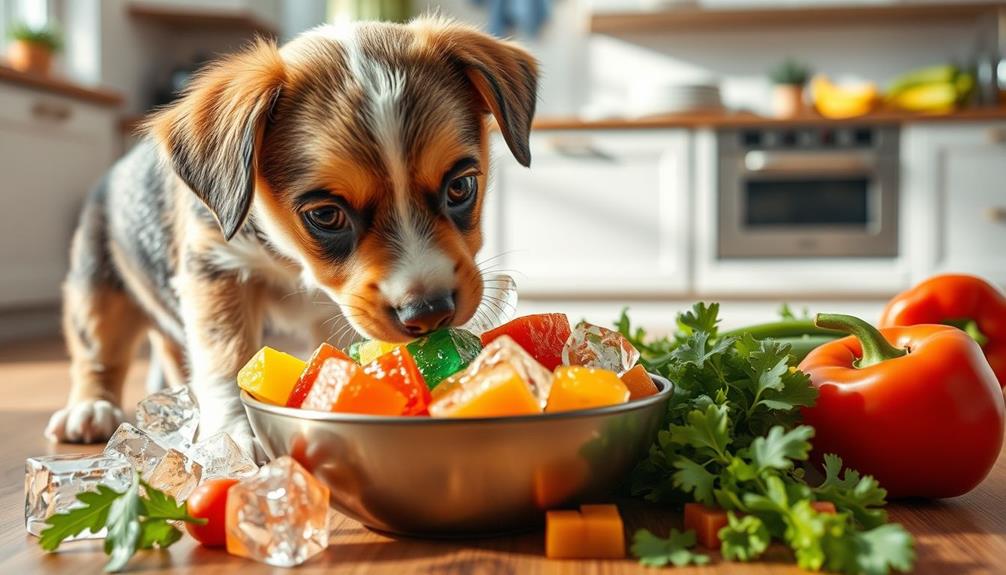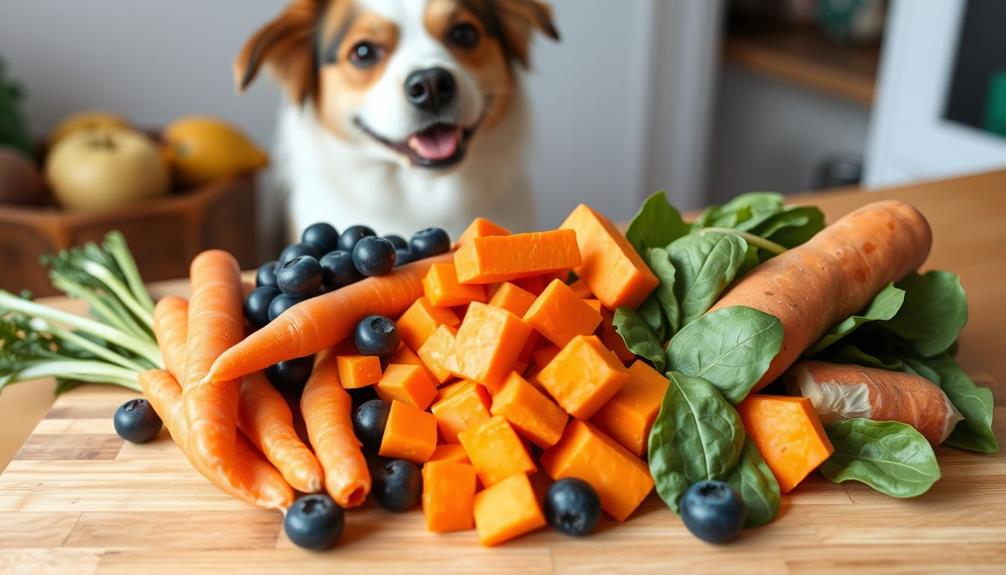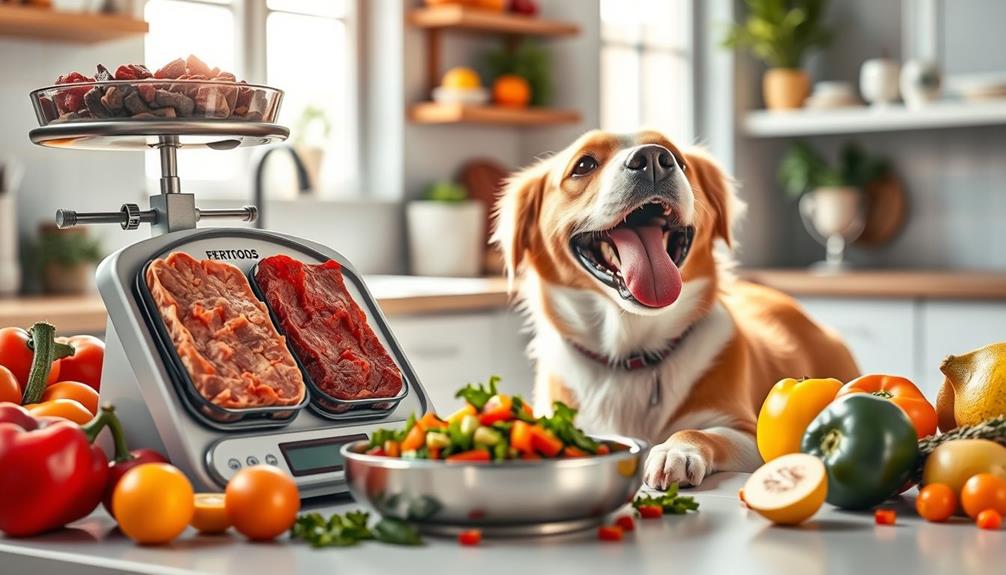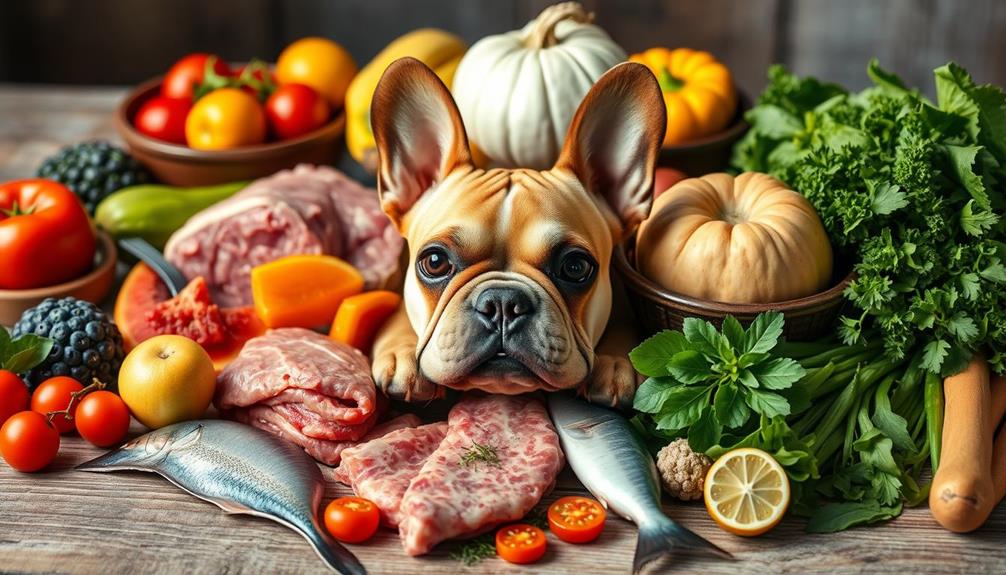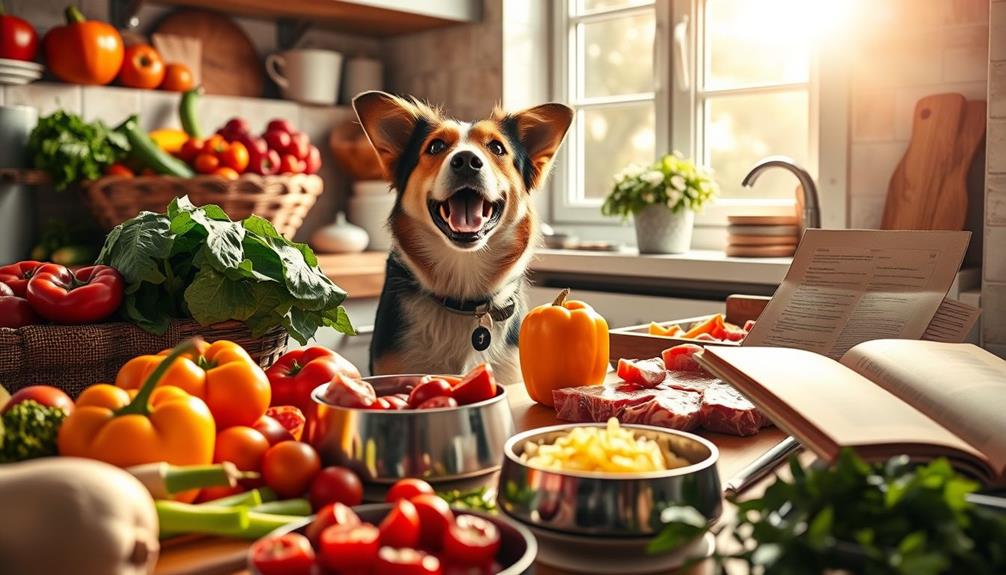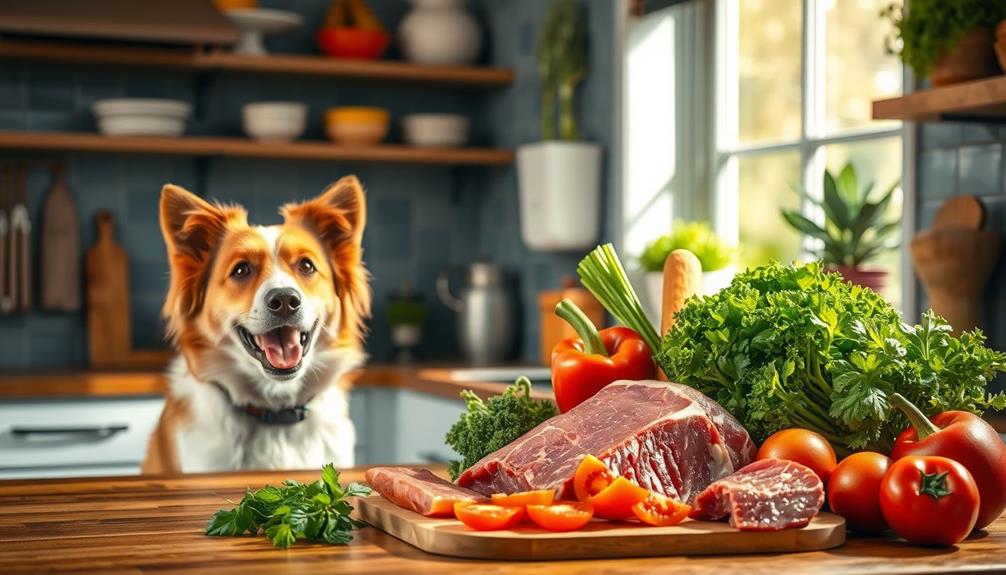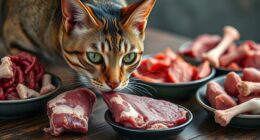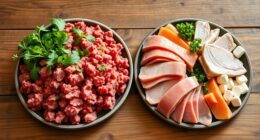Yes, puppies can eat frozen raw food, provided it's properly thawed and nutritionally balanced. This type of diet meets their developmental needs and is packed with essential nutrients. To keep your puppy safe, always thaw the food in the refrigerator or cold water, avoiding room temperature thawing. Be sure to choose brands that meet AAFCO standards for complete nutrition. As you shift to this diet, monitor your puppy's health and stool consistency. If you're curious about safe handling practices or finding the best brands, stick around for more tips and insights!
Key Takeaways
- Puppies can safely eat frozen raw food post-weaning if it meets AAFCO standards for nutritional balance.
- A raw diet should include 80% muscle meat, 10% organs, and 10% bone for proper growth.
- Proper thawing methods, like refrigerator thawing, are crucial to prevent bacterial contamination.
- Monitor your puppy's health and stool consistency during the transition to a raw diet.
- Consult your veterinarian for guidance on raw food diets to ensure nutritional adequacy and safety.
Understanding Frozen Raw Food
When it comes to your puppy's diet, understanding frozen raw food is important for making informed choices. This type of food offers a convenient option for feeding puppies, as it preserves important nutrients while guaranteeing safe consumption if thawed properly.
Puppies can eat raw food as soon as they're weaned, but it's essential to make sure their diet is nutritionally balanced to support their growth. Additionally, recommendations for usage based on symptoms can be beneficial when considering dietary changes for your puppy.
To maintain safety, always thaw frozen raw food in the refrigerator, never at room temperature. This prevents bacterial growth and guarantees that your puppy can enjoy their meal without health risks.
When you introduce frozen raw food, closely monitor your puppy's health and stool consistency to make sure they're adjusting well to this new diet.
Choosing a reputable brand that complies with AAFCO standards is significant. This guarantees that the frozen raw food provides complete and balanced nutrition, helping your puppy thrive.
Nutritional Needs of Puppies
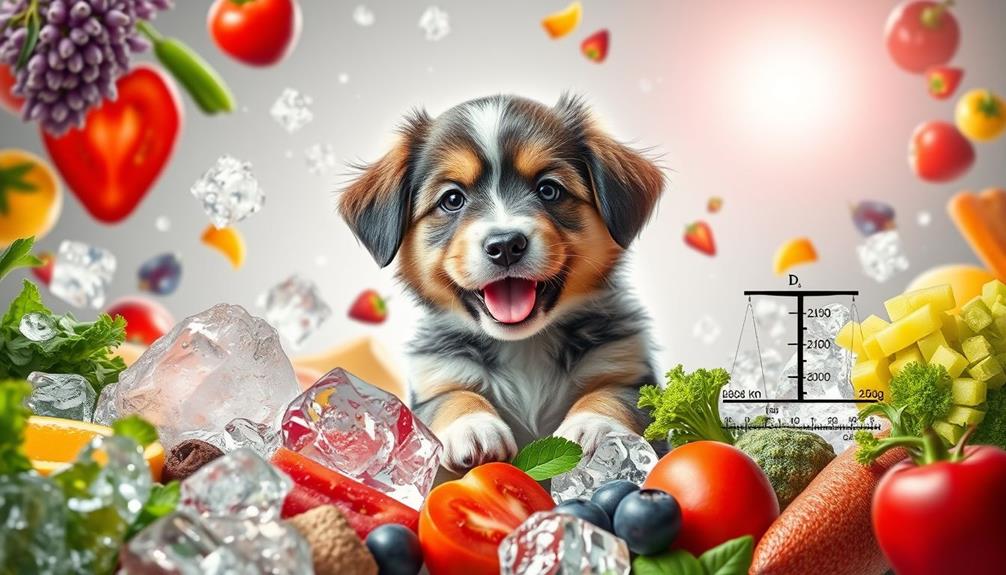
Understanding the nutritional needs of puppies is fundamental for their healthy development and growth. Puppies require a complete and balanced diet that supports their rapid growth, typically needing higher protein and fat levels compared to adult dogs.
It's recommended to feed your puppy about 8-10% of their body weight in food during the early stages of life, specifically 2-4 months old, with three meals per day. Additionally, proper diet includes fresh fruits and vegetables to complement their nutritional intake.
When considering raw food diets for puppies, it's imperative to verify the diet includes 80% muscle meat, 10% organs, and 10% bone. This balance helps meet their essential nutritional needs for peak health. Nutritional imbalances can lead to deficiencies, so consulting with veterinary nutritionists is essential when selecting raw food options.
Puppies can start converting to raw food diets as early as weaning, around 3-4 weeks old. Just make sure the diet you're providing exceeds AAFCO standards for all life stages.
Safe Thawing Practices
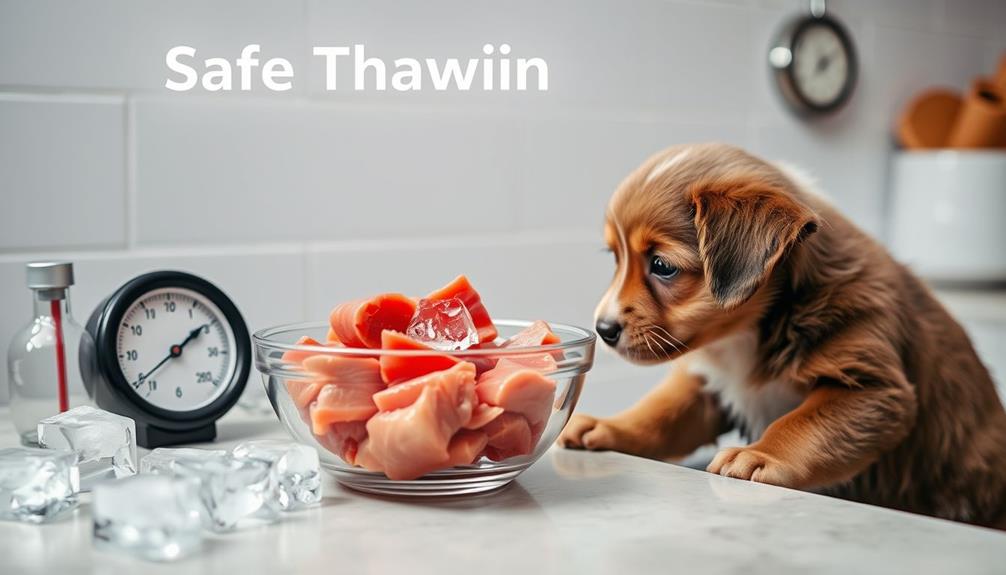
When it comes to thawing frozen raw food for your puppy, using the right techniques is essential. Proper thawing methods not only guarantee the food is safe for consumption but also help maintain its nutritional value.
Thawing in the refrigerator or a cold water bath helps prevent harmful bacteria from growing, while improper methods can pose serious risks.
For instance, understanding financial considerations for elderly care can parallel how we assess the safety of our pets' food.
Let's explore the best practices for safely thawing your puppy's food.
Proper Thawing Techniques
Thawing frozen raw food properly is essential for keeping your puppy safe and healthy. As a pet parent, you want to guarantee that the raw food you serve minimizes the risk of bacterial growth while maintaining food safety.
Additionally, providing your puppy with healthy dog snacks can enhance their overall wellness. Here are three proper thawing techniques to follow:
- Refrigerator Thawing: Always thaw raw food in the refrigerator. This method keeps the temperature controlled, minimizing bacterial growth and guaranteeing your raw meat stays safe for your puppy to eat.
- Cold Water Thawing: For a quicker option, place the sealed raw food in a bowl of cold water. Change the water every 30 minutes, and avoid exceeding two hours for total thawing time.
- Avoid Microwave Thawing: Don't use a microwave to thaw raw food. It can create hot spots that might partially cook the food, compromising its raw state and safety.
Risks of Improper Thawing
Improper thawing of raw food poses considerable risks to your puppy's health. When you thaw raw food at room temperature, it encourages bacterial growth, increasing the chances of contamination and foodborne illnesses. To guarantee food safety, always thaw raw meat in the refrigerator, as recommended by the CDC. This method maintains a safe temperature and minimizes pathogens like Salmonella and Listeria.
Here's a quick reference table to illustrate the risks of improper thawing:
| Thawing Method | Risks |
|---|---|
| Room Temperature | Promotes bacterial growth |
| Refrigerator | Safe, minimizes contamination risk |
| Refreezing Thawed Food | Compromises quality and safety |
| Using Shared Utensils | Increases cross-contamination risk |
Always handle raw food with care. Use separate utensils and surfaces to prevent cross-contamination. Confirm that the thawed raw food looks fresh and has no off-smells before feeding it to your puppies. By following proper thawing practices, you can greatly reduce the risks of foodborne illnesses and keep your furry friends healthy.
Benefits of Frozen Raw Diet
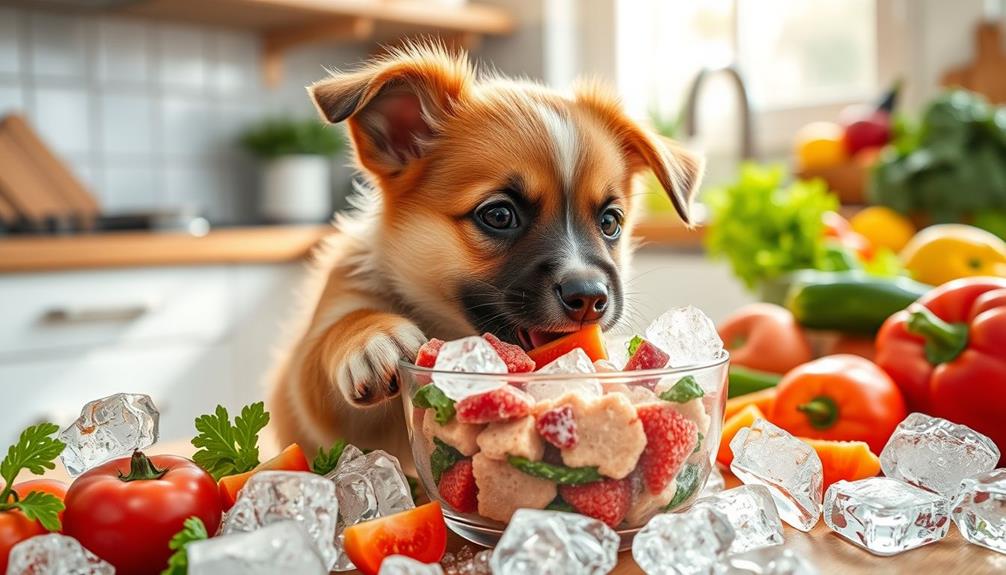
When you choose a frozen raw diet for your puppy, you're ensuring they get maximum nutrients that cooking can strip away.
This diet not only supports safe feeding practices by reducing bacterial risks but also makes meal prep a breeze with easy portioning.
Additionally, incorporating essential oils like eucalyptus oil may help maintain your puppy's overall health.
You'll find that the convenience and health benefits of frozen raw food can lead to happier, healthier pups.
Nutrient Retention Advantages
Many pet owners are discovering the nutrient retention advantages of a frozen raw diet for their puppies. This type of diet preserves essential nutrients that might be lost during cooking, helping your puppy thrive.
Moreover, a well-balanced diet is vital for overall health and can even impact financial planning for pet care as you consider long-term expenses.
Here are three key benefits of frozen raw food:
- Nutrient Preservation: Freezing raw food maintains the integrity of vitamins and minerals, ensuring your puppy gets the essential nutrients they need.
- Reduced Harmful Bacteria: A study shows that freezing raw meat can greatly limit the growth of harmful bacteria while keeping protein digestibility high, promoting a healthy digestive system.
- Convenient Shelf-Stable Option: Frozen raw diets offer a convenient way to provide fresh, nutrient-dense meals without the need for additives or preservatives.
Safe Feeding Practices
Feeding your puppy a frozen raw diet can be a safe and beneficial choice, provided you follow proper practices. First, confirm that the frozen raw food is thawed properly in the refrigerator. This method reduces the risk of bacterial contamination, keeping your puppy healthy.
It's also important to remember that freezing raw meat can help eliminate some pathogens, making it safer for your puppy's consumption. Additionally, incorporating a variety of ingredients can enhance the nutritional profile of your puppy's diet, similar to how juice diets should be balanced to avoid deficiencies.
When choosing frozen raw diets, look for those that meet AAFCO standards, as these products offer a nutritional balance vital for your growing puppy. Puppies generally have adaptable digestive systems that allow them to thrive on frozen raw diets when you introduce the food gradually.
Implementing proper handling and sanitation practices is essential. Always clean surfaces and utensils after preparing frozen raw food to prevent cross-contamination.
Convenient Meal Preparation
Preparing meals with frozen raw diets offers an effortless way to provide your puppy with high-quality nutrition. With the convenience of frozen raw food, you can guarantee balanced nutrition without complicated meal preparation.
Additionally, just like diversifying your retirement portfolio with options such as a Gold IRA, offering your puppy a variety of nutrients can support their overall health. Here are three key benefits:
- Long-Term Storage: Frozen raw food can be stored for extended periods while preserving essential nutrients, making it perfect for busy schedules.
- Easy Thawing: You can easily thaw the food in the refrigerator, reducing the risk of bacterial growth compared to room temperature thawing.
- Tailored Feeding: Portioning the food based on your puppy's weight and age allows for personalized feeding schedules that support ideal growth and development.
Many commercial frozen raw diets are formulated to meet AAFCO standards, guaranteeing your puppy receives balanced nutrition.
This convenience means you can spend less time preparing meals and more time enjoying moments with your furry friend. By incorporating frozen raw food into your puppy's diet, you'll provide them with the high-quality nutrition they need to thrive while simplifying your daily routine.
Risks of Feeding Frozen Raw
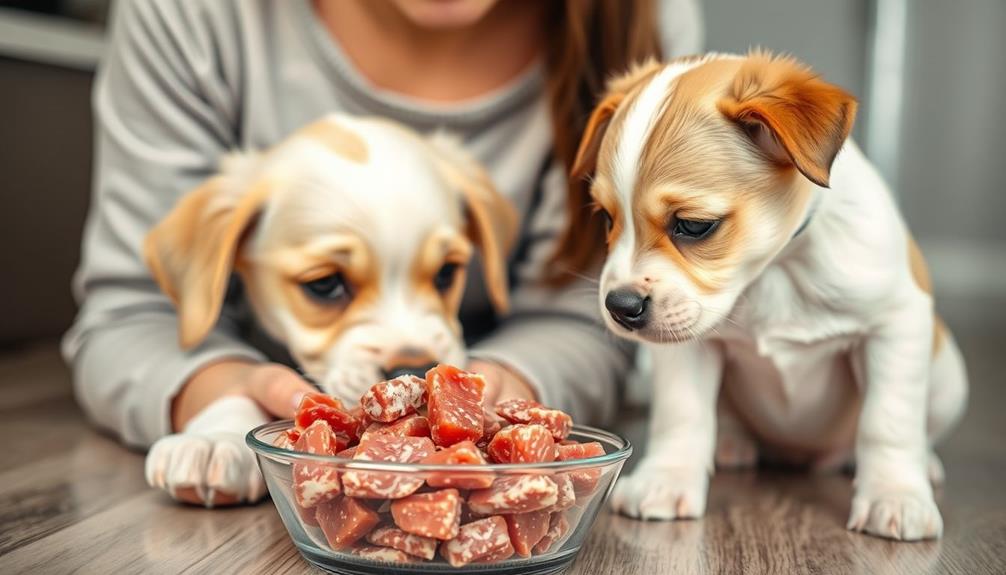
The allure of frozen raw food for puppies can quickly fade when you consider the significant risks involved. Feeding frozen raw food carries the potential for bacterial contamination, including harmful pathogens like Salmonella and Listeria. These can lead to serious illnesses not just for your puppy but also for humans in the household.
Puppies have sensitive digestive systems and are more susceptible to gastrointestinal issues if they consume improperly handled or thawed raw food. Additionally, individuals with Borderline Personality Disorder (BPD) may face challenges in maintaining a consistent routine, which is essential when managing a puppy's diet.
Additionally, rapid growth and changing dietary needs in puppies require a balanced diet. If frozen raw food lacks essential nutrients, it can result in nutritional deficiencies that may affect your puppy's development. Thawing raw meat at room temperature can promote bacterial growth, heightening contamination risks, especially in homes with vulnerable individuals.
Before introducing frozen raw food, it's vital to consult with a veterinarian. They can help guarantee the food meets your puppy's nutritional requirements and advise on safe handling practices. Taking these precautions can safeguard your puppy's health and help you avoid the risks of raw feeding.
Transitioning to a Raw Diet
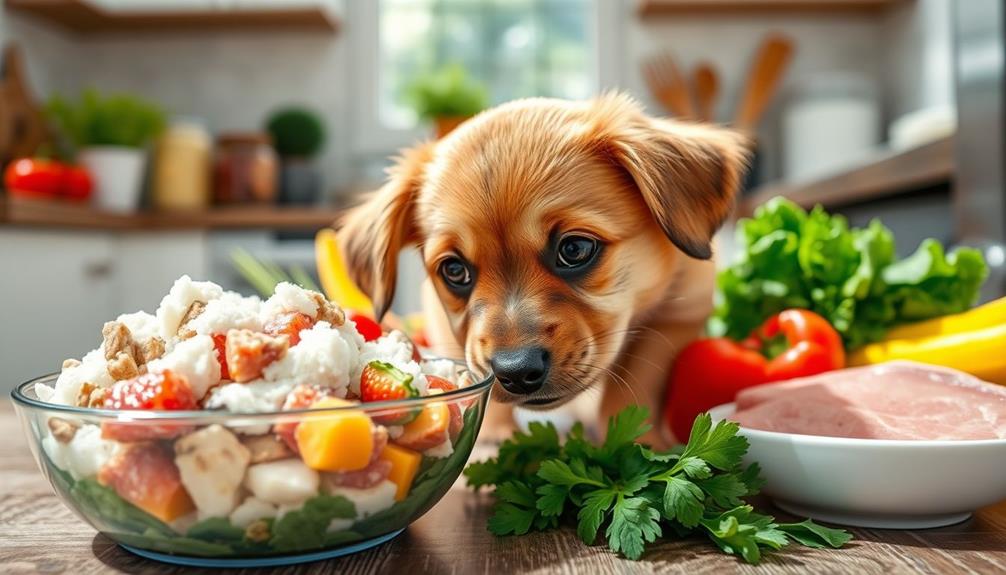
When considering a raw diet for your puppy, it's critical to approach the change thoughtfully. Shifting to a raw food diet can be beneficial, but doing it right is fundamental for their health and development.
As with human infants, puppies undergo important periods for skill acquisition and growth, making proper nutrition essential during this time key domains of development.
Here are three key steps to follow:
- Start with One Protein Source: Begin with a single protein source to monitor how your puppy's digestive system reacts. Puppies should be at least three to four weeks old before starting this shift.
- Monitor Feeding Amounts: During the shift, feed your puppy 8-10% of their body weight if they're 2-4 months old, then reduce to 3-4% as they reach 8-12 months. This helps guarantee balanced nutrition.
- Introduce Diverse Proteins: After initial acclimation, introduce 4-6 different protein sources over time. This variety prevents deficiencies and supports the best growth.
You may notice some loose stools initially, but this usually resolves quickly as your puppy adjusts.
Consulting With a Veterinarian
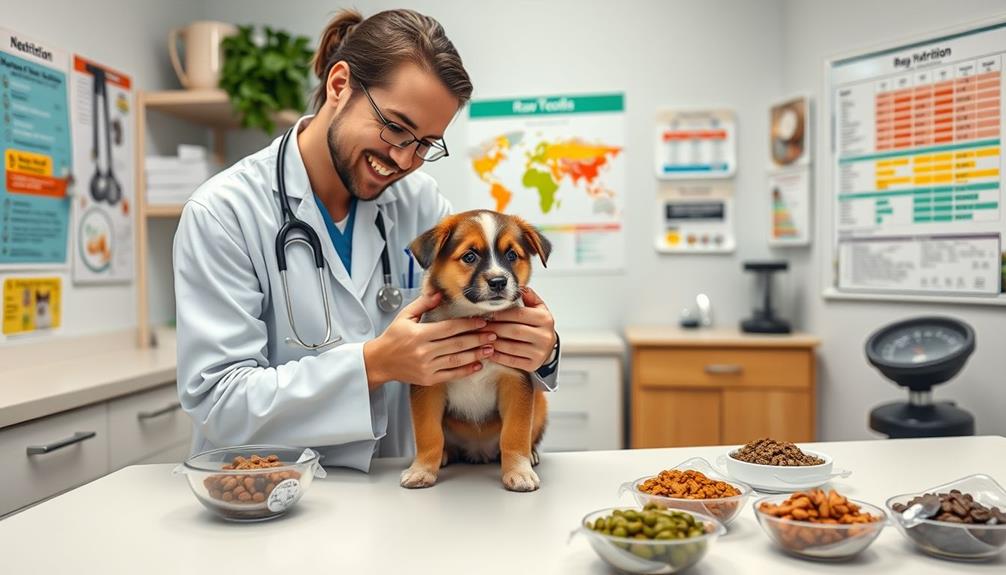
Shifting your puppy to a raw diet opens up significant conversations about their nutritional needs, especially concerning frozen raw food. Consulting with a veterinarian is essential before making this change. They'll help guarantee the frozen raw food you choose meets your puppy's specific dietary requirements for healthy growth and development.
Your vet can provide guidance on the appropriate types and amounts of frozen raw food based on your puppy's age, breed, and health status. If you're considering homemade frozen raw diets, a veterinary nutritionist can evaluate the balance of nutrients to prevent deficiencies that could lead to serious health issues.
Regular veterinary check-ups are important during this change. They allow you to monitor your puppy for any adverse reactions or nutritional imbalances.
Furthermore, your veterinarian can advise you on safe handling and thawing practices for frozen raw food, which is critical to minimize the risk of foodborne illnesses affecting both your puppy and your household.
Best Frozen Raw Food Brands
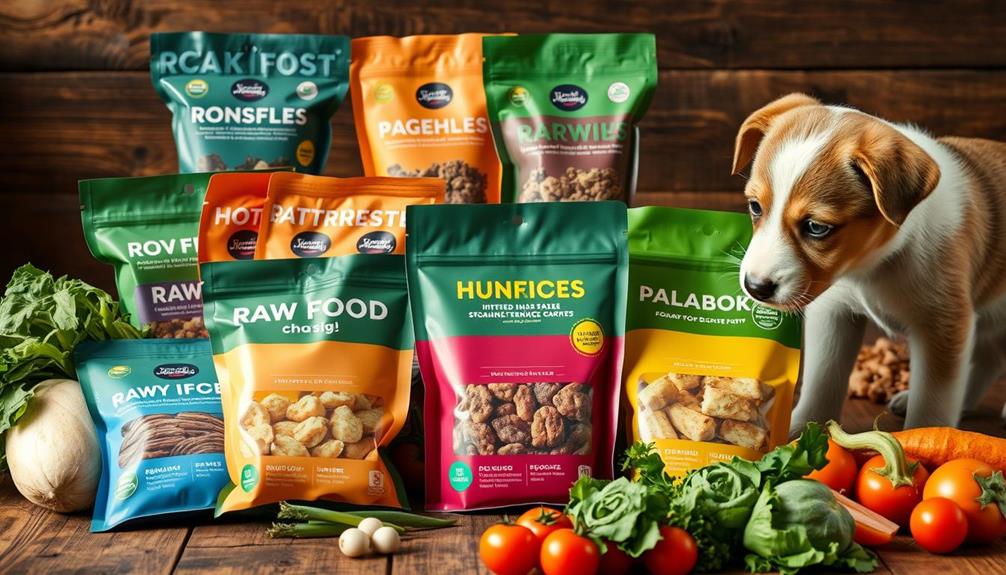
Choosing the right brand of frozen raw food for your puppy can greatly impact their health and development. Here are three top brands you should consider:
- Stella & Chewy's: This brand offers high-quality frozen raw food that meets AAFCO standards for balanced nutrition, making it a great option for growing puppies.
- We Feed Raw: Formulated by a PhD pet nutritionist, their frozen raw patties are specifically designed to meet the nutritional needs of puppies, ensuring they get the right balance of nutrients.
- Primal Pet Foods: Known for its variety of proteins, Primal delivers frozen raw food products made from organic and sustainably sourced ingredients, supporting healthy canine diets.
Additionally, brands like Nraw and Answers Pet Food enhance your puppy's diet with whole prey options and fermentation processes, respectively.
These features promote a diverse diet and improve digestibility. When selecting frozen raw food, prioritize high-quality ingredients and balanced nutrition to support your puppy's growth and overall health.
Always consult with your vet to find the best option tailored to your puppy's specific needs.
Frequently Asked Questions
Can Puppies Eat Frozen Raw Food?
Yes, puppies can eat frozen raw food, but you need to thaw it properly. Start slowly with one protein source to watch for allergies, and consult your vet to guarantee it meets their nutritional needs.
Is Frozen Raw Dog Food Safe?
Yes, frozen raw dog food can be safe, provided you source it from reputable suppliers. Always thaw it properly, supervise your puppy during meals, and consult your vet to guarantee a balanced diet.
At What Age Can Puppies Eat Raw Meat?
Puppies can start eating raw meat at around 3-4 weeks old, right after weaning. It's important to introduce it gradually, ensuring a balanced diet to support their growth and prevent nutrient deficiencies.
Can I Feed My Puppy Freeze-Dried Raw Food?
You might worry about raw food's safety, but you can definitely feed your puppy freeze-dried raw food. Just make certain it meets AAFCO standards, introduce it gradually, and consult your vet for the best changeover.
Conclusion
In summary, feeding your puppy frozen raw food can be a healthy choice if done correctly. Just like planting a seed, nurturing this diet with safety and care can help your pup flourish. Remember to thaw properly and consult your veterinarian to guarantee you're meeting their nutritional needs. With the right approach, you'll be setting your furry friend on a path to vibrant health and happiness. So, begin this journey with confidence!

